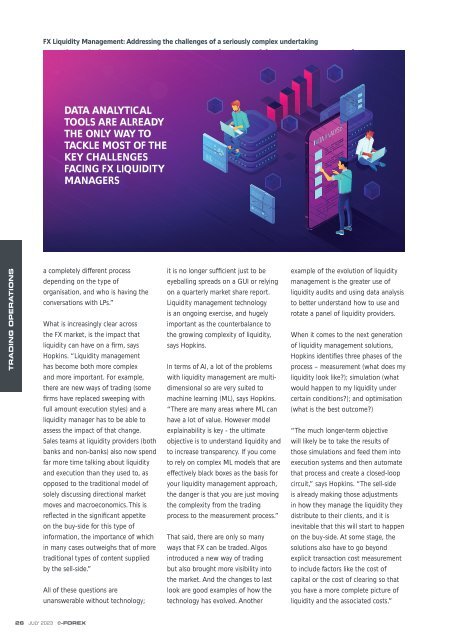You also want an ePaper? Increase the reach of your titles
YUMPU automatically turns print PDFs into web optimized ePapers that Google loves.
FX Liquidity Management: Addressing the challenges of a seriously complex undertaking<br />
DATA ANALYTICAL<br />
TOOLS ARE ALREADY<br />
THE ONLY WAY TO<br />
TACKLE MOST OF THE<br />
KEY CHALLENGES<br />
FACING FX LIQUIDITY<br />
MANAGERS<br />
TRADING OPERATIONS<br />
a completely different process<br />
depending on the type of<br />
organisation, and who is having the<br />
conversations with LPs.”<br />
What is increasingly clear across<br />
the FX market, is the impact that<br />
liquidity can have on a firm, says<br />
Hopkins. “Liquidity management<br />
has become both more complex<br />
and more important. For example,<br />
there are new ways of trading (some<br />
firms have replaced sweeping with<br />
full amount execution styles) and a<br />
liquidity manager has to be able to<br />
assess the impact of that change.<br />
Sales teams at liquidity providers (both<br />
banks and non-banks) also now spend<br />
far more time talking about liquidity<br />
and execution than they used to, as<br />
opposed to the traditional model of<br />
solely discussing directional market<br />
moves and macroeconomics. This is<br />
reflected in the significant appetite<br />
on the buy-side for this type of<br />
information, the importance of which<br />
in many cases outweighs that of more<br />
traditional types of content supplied<br />
by the sell-side.”<br />
All of these questions are<br />
unanswerable without technology;<br />
it is no longer sufficient just to be<br />
eyeballing spreads on a GUI or relying<br />
on a quarterly market share report.<br />
Liquidity management technology<br />
is an ongoing exercise, and hugely<br />
important as the counterbalance to<br />
the growing complexity of liquidity,<br />
says Hopkins.<br />
In terms of AI, a lot of the problems<br />
with liquidity management are multidimensional<br />
so are very suited to<br />
machine learning (ML), says Hopkins.<br />
“There are many areas where ML can<br />
have a lot of value. However model<br />
explainability is key - the ultimate<br />
objective is to understand liquidity and<br />
to increase transparency. If you come<br />
to rely on complex ML models that are<br />
effectively black boxes as the basis for<br />
your liquidity management approach,<br />
the danger is that you are just moving<br />
the complexity from the trading<br />
process to the measurement process.”<br />
That said, there are only so many<br />
ways that FX can be traded. Algos<br />
introduced a new way of trading<br />
but also brought more visibility into<br />
the market. And the changes to last<br />
look are good examples of how the<br />
technology has evolved. Another<br />
example of the evolution of liquidity<br />
management is the greater use of<br />
liquidity audits and using data analysis<br />
to better understand how to use and<br />
rotate a panel of liquidity providers.<br />
When it comes to the next generation<br />
of liquidity management solutions,<br />
Hopkins identifies three phases of the<br />
process – measurement (what does my<br />
liquidity look like?); simulation (what<br />
would happen to my liquidity under<br />
certain conditions?); and optimisation<br />
(what is the best outcome?)<br />
“The much longer-term objective<br />
will likely be to take the results of<br />
those simulations and feed them into<br />
execution systems and then automate<br />
that process and create a closed-loop<br />
circuit,” says Hopkins. “The sell-side<br />
is already making those adjustments<br />
in how they manage the liquidity they<br />
distribute to their clients, and it is<br />
inevitable that this will start to happen<br />
on the buy-side. At some stage, the<br />
solutions also have to go beyond<br />
explicit transaction cost measurement<br />
to include factors like the cost of<br />
capital or the cost of clearing so that<br />
you have a more complete picture of<br />
liquidity and the associated costs.”<br />
26 JULY 20<strong>23</strong> e-FOREX
















